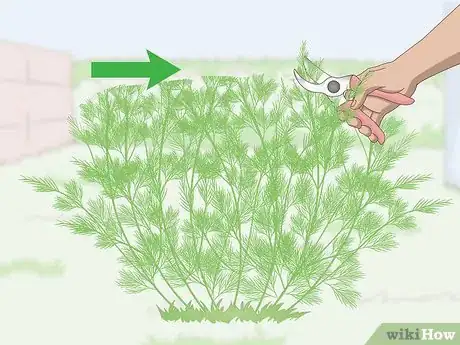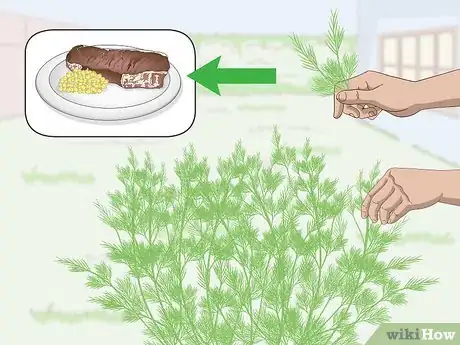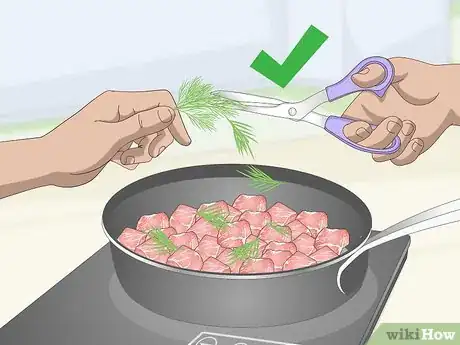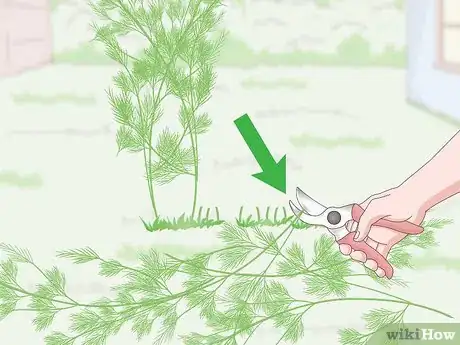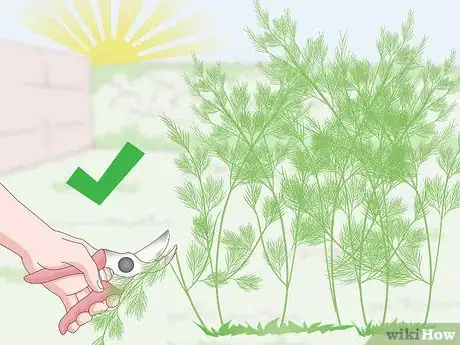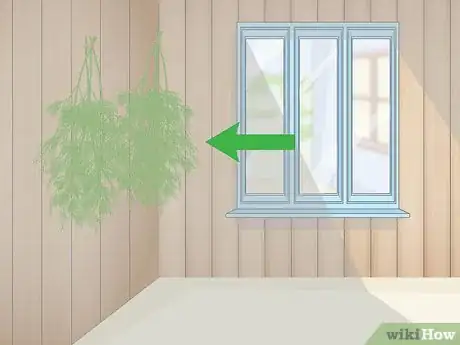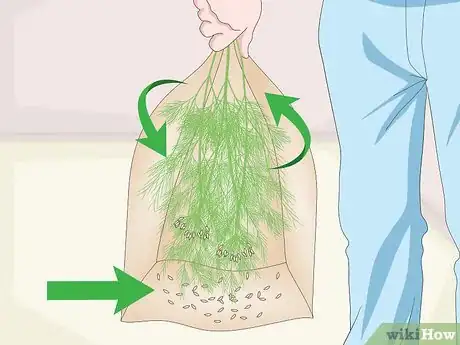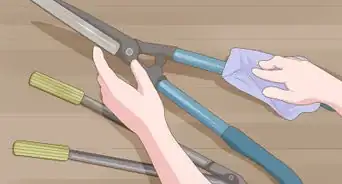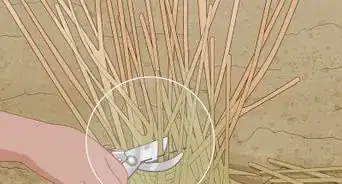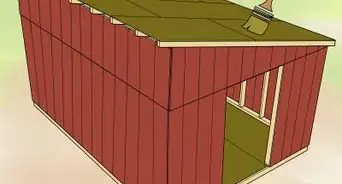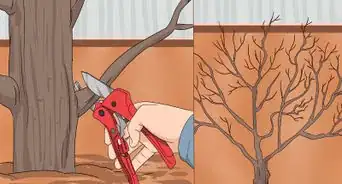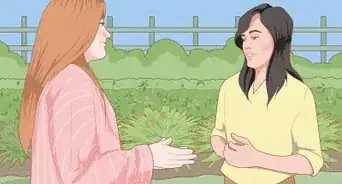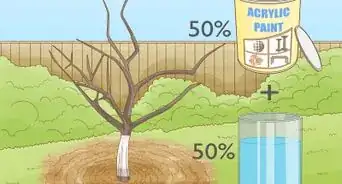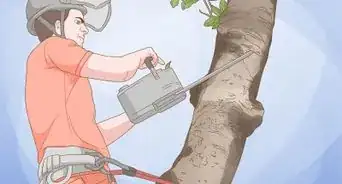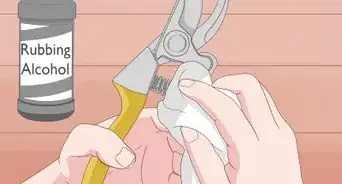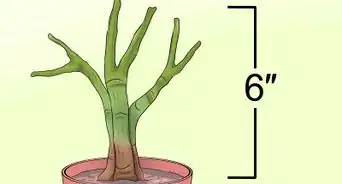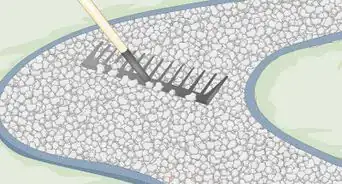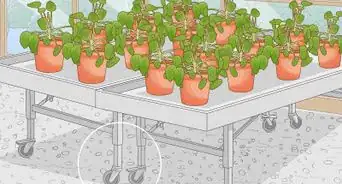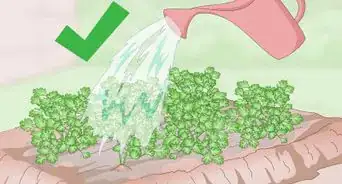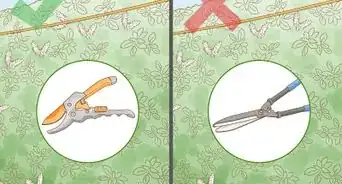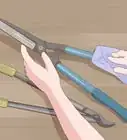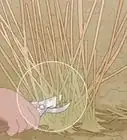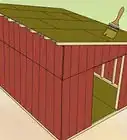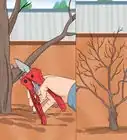This article was co-authored by Lauren Kurtz. Lauren Kurtz is a Naturalist and Horticultural Specialist. Lauren has worked for Aurora, Colorado managing the Water-Wise Garden at Aurora Municipal Center for the Water Conservation Department. She earned a BA in Environmental and Sustainability Studies from Western Michigan University in 2014.
There are 9 references cited in this article, which can be found at the bottom of the page.
This article has been viewed 93,198 times.
Dill is a tender herb that grows rapidly without much help. While you can prune it back to shape it, you generally don't need to. However, you can trim it to harvest some of the dill all throughout the growing season to use and store. At the end of the growing season, cut the dill back to the ground and save the herbs by drying them.
Steps
Cutting and Shaping Dill
-
1Trim leaves from the top to encourage bushier growth. Try to pick leaves near the top of the plant to trim off. That will encourage the plant to grow outward rather than upward.[1]
- When you look at a dill plant, you'll see many tiny stems going off the main branch, each with little fern-like fingers on it. Each of these tiny stems is a leaf.
-
2Pinch off small branches here and there for flavoring your food. If you just want a bit of dill for your dinner, you can simply use your fingers to remove a few branches. They are soft enough that you shouldn't have trouble pulling them off this way.[2]
- This doesn't hurt the plant as long as your careful not to yank it so much that it pulls out of the ground.
Advertisement -
3Prune or harvest all throughout the season. Some plants don't like pruning at certain times of the season. However, with dill, you can prune or harvest it any time it is green and growing.[3]
- However, you may want to wait for it to mature before you prune it heavily. It usually takes about 8 weeks to grow from seed to a mature plant.
-
4Leave at least 2/3 of the plant when pruning. When you're pruning or harvesting, try not to cut more than 1/3 of the plant off. You want to leave enough leaves on the plant that it still has a chance to gather the sun it needs.
- If you cut too much, your plant could wither.
-
5Pinch off flowers to keep the plant from going to seed. During the growing season, it's a good idea to pinch off flowers as they come in. That keeps the plant growing. If you let the plant go to seed, it will generally die off. Pinch the stem where the flower's branch meets another branch. Nip it just above the joint.[4]
- Dill flowers are tiny and yellow. They cluster in rings near the top of the plant.
- At the end of the season, you can either harvest the seeds or let the plant reseed itself. Reseeding just means you let the plant drop its seeds in the ground so it comes back next year.
Storing and Using Fresh Dill
-
1Use your dill as quickly as you can. If possible, use your dill within a couple of hours. It will have the most flavor in this time period. For that reason, it's best to cut it right before you want to use it in your food.[5]
- Try cutting dill with scissors instead of a knife when preparing it in the kitchen. It will be more flavorful.[6]
-
2Cut branches off the main stem when you're planning to store dill. When looking at the plant, look for shoots going off the main stem at a perpendicular angle. Use small shears to cut the shoot about 1 inch (2.5 cm) or less above the joint.
- Cutting causes less damage to the plant, so it keeps it from decaying as fast if you're planning on storing it.[7]
-
3Store dill in a jar in the refrigerator. Add 1 to 2 inches (2.5 to 5.1 cm) of water to the bottom of a mason jar. Snip off the bottom of the stems on the dill, and place the dill stem-side down in the water. Cover it with a lid, if possible, and put it in the fridge.[8]
- If a lid won't fit over the jar, use a plastic bag and a rubber band.
- Store the herbs for up to 2 weeks.
Harvesting Dill at the End of the Season
-
1Spray the dill with water the day before you harvest it. To harvest whole dill plants, wait until the plant has flowers but hasn't bloomed. Spraying the plant the day before you harvest ensures the plant is clear of dirt when you do cut it.[9]
- You don't want water on the plant the day you harvest, as that can lead to decay.
-
2Cut dill to the ground at the end of the growing season. Dill is an annual, so at the end of the season, you can simply cut it at the base of the stem. Use pruning shears to cut off the plant.[10]
-
3Cut the dill in the morning to ensure the plant has moisture. You want the plant to be hydrated it when you cut it. If you can't cut it in the morning, place the stems in a glass of water like you would flowers.[11]
- Leave them in the water for 2 hours.
-
4Hang the dill to dry. Combine the dill into small bundles, and place rubber bands around them to keep them together. Pick an area that's dark and warm with low humidity. Hang the bunches up to dry.[12]
- Don't make the bundles too tight. Loose bundles promote air circulation, discouraging mold growth.
- Leave them for 1-2 weeks. They're ready when the leaves are dry enough to crumble in your hand. Crumble the dill into a jar, or store it whole in an airtight container.
- Check the jar after a week for moisture. If you see any, take the dill out of the jar and spread it out to dry.
-
5Save seeds by hanging the plants upside down in a bag. Watch for the blooms, and then the seeds. Cut the stalk 4 inches (10 cm) below the flower once the seeds have appeared. Don't wait for them to start dropping off the plant.
- Place the plants in bag, and hang them up. The seeds will fall into the bag.
References
- ↑ https://www.youtube.com/watch?v=zQfRGYkcSK4&feature=youtu.be&t=178
- ↑ https://www.almanac.com/plant/dill
- ↑ https://www.youtube.com/watch?v=zQfRGYkcSK4&feature=youtu.be&t=63
- ↑ https://www.youtube.com/watch?v=zQfRGYkcSK4&feature=youtu.be&t=80
- ↑ https://www.klru.org/ctg/resource/dill/
- ↑ http://veggieharvest.com/herbs/dill.html
- ↑ http://sonomamg.ucanr.edu/Food_Gardening/Additional_KG_Articles/Harvesting_and_Preserving_Dill/
- ↑ https://www.seriouseats.com/2015/04/the-best-way-to-store-fresh-herbs-parsley-cilantro-dill-basil.html
- ↑ http://sonomamg.ucanr.edu/Food_Gardening/Additional_KG_Articles/Harvesting_and_Preserving_Dill/
About This Article
Dill can be pruned any time of year when it's green and growing. Trim the leaves from the top, which will encourage the plant to grow outwards instead of upwards. However, make sure you leave at least two thirds of the plant when you prune it so it doesn’t wither. Whenever you notice flowers growing on your plant, pinch them off with your fingers. This will keep your plant from going to seed and keep it healthy. If you’re picking dill for your food, you can just pinch off small branches with your fingers. If you want to store dill, cut shoots growing off the main stem at a perpendicular angle. For more tips from our Gardening co-author, including how to store your fresh dill, read on!
